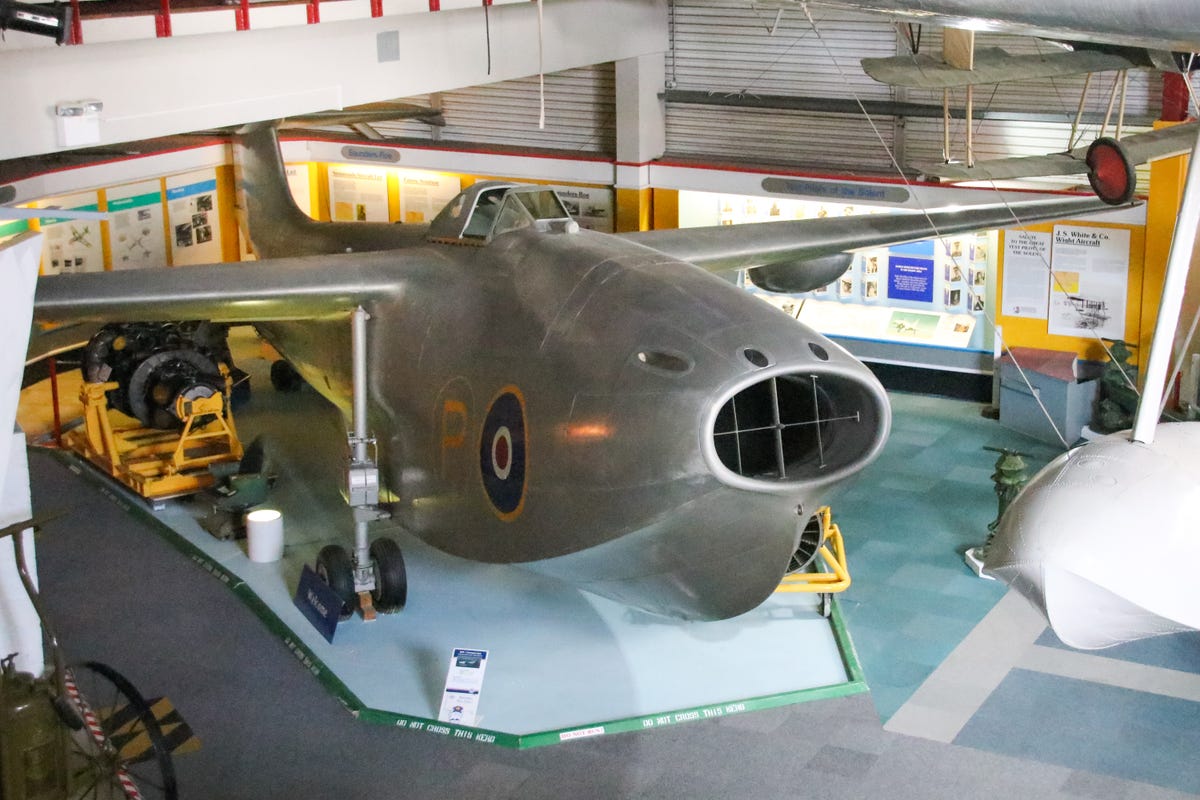
Solent Sky museum
The Solent Sky museum is dedicated to flying boats and other aircraft, and the first plane you see upon entering is the Saunders-Roe SR.A/1. It's rare, and not just because only a few were built. It's one of the few small flying boats (most this size are seaplanes with pontoons). It's also one of the only jet-powered seaplanes/flying boats. Lastly, the first two Marin-Baker ejection seats were fitted on the first two prototypes.
For the full story behind the tour, check out The fabulous flying boats of the Solent Sky museum.
Instruments of history
Several display cases near the entrance show off various memorabilia, including this collection of instruments through the ages.
Sea Vixen
Not a seaplane itself, the Sea Vixen was certainly made for the sea. Over it, to be specific, being an early carrier-based jet.
Rigged for launch
This one is set up as it would have been before a carrier launch. Wings down and engine covers out first, ideally.
Under some shade
The Short Sandringham is a big plane; most of the other planes here are nestled in under its wings.
Spitfire
The Supermarine Spitfire firmly established the Supermarine name in history. The Spitfire, along with the Hawker Hurricane, defended the skies above the UK during the Battle of Britain.
Trainers
Two training cockpits of different eras; one for a Harrier on the left and one for a Supermarine Swift on the right.
Swift
The Swift is an early jet fighter from the '50s, so its cockpit is a bit more advanced than the Spitfire's (which you'll see in a moment). This trainer was built out of an extra airframe in 1954.
Last batch
This is a Mk24 Spitfire, the last incarnation. This one, "PK683," is from the final batch, and is on loan from the RAF Museum.
Spitfire cockpit
The many dials and controls of the Mk24 Spitfire.
Walkways
The layout of the museum is great, letting you see all the aircraft from just about every angle.
Anchor's aweigh
In its military garb this would have held the forward gun turret that would be winched back into the airframe to give a crewman access in case they needed to tie off to a dock or other boat. As you can see, there's also an anchor, if required.
Gnat
Though it doesn't look it, the Folland Gnat is actually one of the smallest planes here.
504J
This is a replica of the plane that the man who would become King George VI learned to fly on.
Not exactly 'short'
The 112.8-foot/34.4m wingspan was needed to help lift the chubby bulk of the flying boat.
SUMPAC
The SUMPAC , or Southampton University Man Powered Aircraft, was as, the name implies, a plane powered by one (un)lucky human.
A pair of Shorts
The Sandringham is the civilian version of Short's Sunderland. For a tour of a military-spec Sunderland, check out my tour of RAF Museum London.
All aboard
This Sandringham was owned by Charles Blair, Jr. while he was married to Maureen O'Hara. He used it in his Caribbean airline business (though when he owned it, it was called "Southern Cross"). It was built in 1943 as a Sunderland Mark III, converted to a Mark V with Pratt & Witney engines in 1944, and demilitarized and converted to a Sandringham in 1947.
Bow
Some front luggage space. This is the main cabin deck; the cockpit is directly above where I'm standing. Behind the hatch is access to the open area with the anchor you saw earlier. To my right are two bathrooms -- with windows!
Seats in the back
Lots of room back here. I'm just under six feet, and the ceiling was close enough to make me notice, but not to have to duck. A hatch here (and in the room on the deck above) give access to the baggage hold.
Items may have shifted...
I'm guessing they tied everything down using the holes in the support beams. Otherwise, what a mess to deal with.
Comfy cabin
This photo gives you an idea of the cabin layout. Here you can see the first three of four rooms on this deck. Each has eight seats (the rear-most room has seven). With the exception of the second room, there's lots of legroom.
In case of a land landing
Fun factoid here: all the windows can be used for escape. "Give a sharp blow to one edge of window with foot or hand."
Stairs on a plane
Though you rarely see them, most long-haul aircraft (like the 787) have stairs to access crew rest areas that are out of sight and off-limits to passengers.
Upper deck
The seats are the same, but maybe the view is better up here? (If you ever have a chance to fly on the top deck of a 747, I recommend it.)
The door in the back goes to the luggage compartment you saw earlier.
Galley
A very boat-like galley. The opening on the right offers a view of the cockpit and "radio room."
Cockpit
A skinny ladder and hatch are the only access to the bridge/cockpit. This view, looking aft, shows the "radio room." The table at the bottom would have been what the top gunner would have stood on.
Mechanical controls
No fly-by-wire here.
Bob
After popping up through the top hatch, I spotted Robert. He seemed very intent on his maintenance work and didn't acknowledge me at all. Rather rude, that.
Radio
The stations for the engineer and, to the right, where the radio operator would have sat. The galley is on the other side of the far wall.
Powerful prop
Even with four 1,200hp engines, top speed was only around 200mph.
Solent speed
One last view of the S.6, with a Tiger Moth above.
For the full story behind the tour, check out The fabulous flying boats of the Solent Sky museum.

